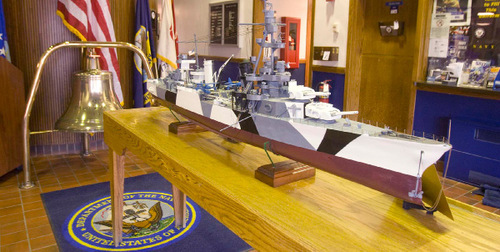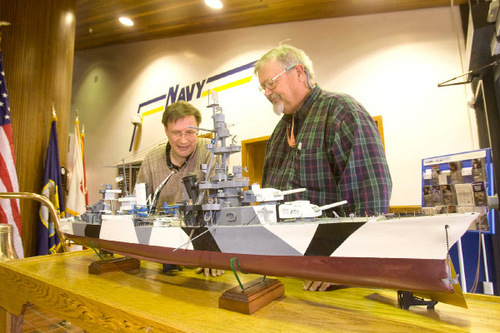This is an archived article that was published on sltrib.com in 2010, and information in the article may be outdated. It is provided only for personal research purposes and may not be reprinted.
When the Navy used the U.S.S. Salt Lake City for target practice and sank her 130 miles off the Southern California coast on May 25, 1948, William Leary was heartbroken.
After all, the now 90-year-old veteran spent much of World War II serving on the Pensacola Class-cruiser that earned the moniker "The One Ship Fleet" because of its success in battle.
"It was the first heavy cruiser in the Navy and had a terrific history with all the action it saw," said Leary from his California home. "We never got the credit for what we did."
With Veteran's Day on Thursday, the U.S.S. Salt Lake City memories live in the hearts of the few crew members who are still alive.
Oklahoman Sandra Eskew is also doing her best to help family members remember the ship. Her late father, Hoyt Thompson, was a member of the crew.
"When he passed away over 20 years ago at the age of 63, I never got a chance to find out much from him," said Eskew, who compiled as many stories, journals, newspaper articles and artifacts as she could find and attended numerous crew reunions.
The website she developed — http://www.ussslcca25.com — contains more than 4,500 pages of information including dozens of stories compiled from those who served on the ship and their families. As the information and memorabilia piled up, it almost filled Eskew's living room.
Roy Webb, a historian and archivist at the University of Utah Marriott Library Special Collections area, offered to help.
While he was aware of the U.S.S. Salt Lake City submarine that was commissioned in 1984, he never knew about the cruiser or its distinguished World War II history until he published an article on the ship in the 1990s.
"I found out it had a distinguished career and was a lucky ship that never sustained any major damage," said Webb. "It fought all the way through the Pacific War."
While on a Grand Canyon river trip in 1995, he met a ship veteran named Bernie Goode. The veteran told of how he was hit in the head with a heavy line shot from a gun. The line went through his face and out the back of his head. Medics cauterized the wound and snipped off the line. Though he experienced sinus problems, Goode lived a productive life.
Webb used Eskew and her archives when he wrote another article on the ship in 1998. While preparing a talk on the Salt Lake City last summer, he contacted Eskew again. She mentioned that she was concerned about what would happen to her collection. Webb offered to store it at the Marriott Library.
"I couldn't find a better place than that," said Eskew. "Roy promised to make it available to anyone who needs it and to keep the history alive. ... I was extremely happy and the veterans I have told about it were thrilled it will be preserved. Old newspapers disintegrate. This has taken a burden off me."
Webb plans to display some of the artifacts, photos and newspaper articles from the collection at the Marriott Library starting Veteran's Day until the end of the year.
There are also two models of the ship in Utah, one at the Fort Douglas Museum and another at the Naval and Marine Reserve Center near the fort. That display also includes the ship bell.
The U.S.S. Salt Lake City was christened Jan. 22, 1929, at Camden, N.J. Then-Utah Sen. Reed Smoot selected Helen Budge, the daughter of a Salt Lake lawyer, to christen the vessel. She was studying music in New York at the time. John Bowman, then the Salt Lake mayor, picked Gayle Rich to be the maid of honor at the ceremony.
Navy historians give the Salt Lake City credit for sinking or helping to sink 15 enemy vessels, damaging at least 10 others and destroying or aiding in the destruction of 12 planes. It also participated in the bombing of 12 Japanese land bases. Though the ship suffered heavy damage in the battle for the Komandorski Islands and came close to sinking, just 11 sailors serving on the ship lost their lives in battle.
"We lucked out so many times," said Leary. "After we landed the marines on the Solomon Islands, we were supposed to go into the harbor that night. We found out we had the wrong kind of ammo. All four cruisers got sunk that night in the harbor."
He remembered watching shrapnel take the hand off a sailor on the Salt Lake City while he shot a 5-inch gun in a night battle. The sailor stayed on the guns until a second one ripped his stomach open. Leary said the serviceman just fell off the gun and died.
Salt Lake resident John Nickas, who turns 86 on Nov. 18, served on the ship as a yeoman for the executive officer for 2-1/2 years, starting in the summer of 1943. His first battle came on his 19th birthday in the battle of Tarawa. He became more than a little nervous when a 16-inch enemy gun firing from the island came close to hitting the ship.
"I was a snot-ass kid and that was my first engagement," he recalled. "It was one hell of a frightening experience."
Nickas was on the ship when it survived hurricane-like conditions, during the invasion of the Philippines and in the famous battle for Iwo Jima. He recalled listening to Tokyo Rose telling men on the ship to write their last letter home because they were about to die.
Veterans such as Leary remember the ship fondly.
"It was a great ship and it was honor to serve on it," he said. "I think about it every day, about all the young kids and the guys who got killed."
wharton@sltrib.com USS Salt Lake City
Pensacola class heavy cruiser
Launched • Jan. 23, 1929
Designated • Test Ship for "Operation Crossroads: at Bikini Atoll where ship survived atomic aerial burst on July 1, 1946, and subsurface burst on July 25, 1946.
Decommissioned • Aug. 29, 1946
Sunk as Target • May 25, 1948, 130 miles off the Southern California Coast
Nicknames • "The Swayback Maru," "The Queen of the Sea," "The One Ship Fleet"
Constructed by • New York Shipbuilding Co., Camden, N.J.
Displacement • 9,100 tons
Crew size • Up to 1,200
Dimensions • 585 feet by 6 inches by 65 feet, 3 inches by 22 feet
Armament • Ten, 8-inch canons; eight, 5-inch cannons; four aircraft.
Speed • 32.5 knots
Historical website • http://www.ussslcca25.com —
Documentary seeks to help veterans
Director of new documentary "Wartorn" says silence about war experience hurts veterans and families. › B2





